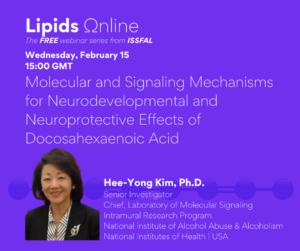Lipids Online, KIM Webinar from ISSFAL, Wednesday, February 15, 2023 15:00 GMT
LIPIDS ΩNLINE WEBINAR FROM ISSFAL Wednesday, February 15, 2023 15:00 GMT
Hee-Young Kim
"Molecular and Signaling Mechanisms for Neurodevelopmental and Neuroprotective Effects of Docosahexaenoic Acid"

The neurodevelopmental and neuroprotective actions of docosahexaenoic acid (DHA) are mediated by mechanisms involving membrane- and metabolite-related signal transduction. A key characteristic in the membrane-mediated action of DHA results from the stimulated synthesis of neuronal phosphatidylserine (PS). The resulting DHA-PS-rich membrane domains facilitate the translocation and activation of kinases such as Raf-1, protein kinase C (PKC), and Akt. The activation of these signaling pathways promotes neuronal development and survival. DHA is also metabolized to N-docosahexaenoylethanolamine (synaptamide) that promotes neurogenesis and synaptogenesis and exerts anti-inflammatory effects. Synaptamide binds to the GAIN domain of the GPR110 (ADGRF1) receptor, triggers the cAMP/protein kinase A (PKA) signaling pathway, and activates the cAMP-response element binding protein (CREB). The DHA status in the brain influences not only the PS-dependent signal transduction but also the metabolite formation and expression of pre- and post-synaptic proteins that are downstream of the CREB activation and affect neurotransmission. The combined actions of these processes contribute to the neurodevelopmental and neuroprotective effects of DHA.

